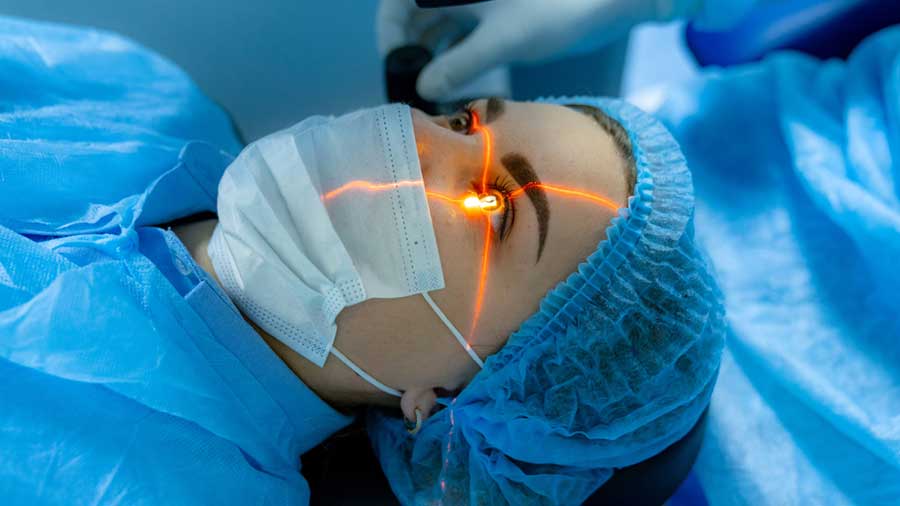
iLasik is an abbreviation for ‘Advanced Laser-Assisted In-Situ Keratomileusis.’ It is a refractive surgical procedure used to correct vision problems and improve visual acuity. This treatment is performed by eye doctors to correct vision impairments and reduce a patient’s dependence on glasses or contact lenses.
What Is an iLasik Laser?
iLASIK laser surgery is also known as bladeless laser surgery. It is a personalized laser treatment method used to permanently correct refractive errors such as hyperopia, astigmatism, and myopia. It is also employed in creating channels for the placement of rings required for the treatment of keratoconus.
What Is Wavefront?
Wavefront is a term that describes the overall behavior of a light wave or electromagnetic wave on a surface or within a medium.
In eye surgery, wavefront analysis is used to evaluate how a person’s eye’s optical system functions. This analysis is performed to detect optical imperfections in the eye (e.g., myopia, hyperopia, astigmatism) and determine the surgical intervention required to correct these imperfections.
Wavefront analysis identifies situations where light from a person’s eye does not focus properly on the retina. This analysis is conducted using specialized computer software and a device that measures wavefront data. The measured data map a person’s vision errors and determine how surgical intervention should be personalized.
Who Is Suitable for iLasik Laser?
iLasik laser treatment is used to correct common vision disorders such as myopia (nearsightedness), hyperopia (farsightedness), and astigmatism. Suitability depends on an individual’s eye structure, age, and eye health. Generally, it is suitable for healthy adults aged 18 and older. However, the following criteria are considered:
- The degree and stability of the prescription for glasses or contact lenses in the last year.
- Corneal thickness.
- Overall health.
What Are the Advantages of iLasik Laser Treatment?
iLasik laser treatment offers several advantages:
- Many people can return to their normal activities quickly after the treatment.
- Reduces dependence on glasses and contact lenses.
- Provides long-term results that often remain stable with age.
- Minimal discomfort or pain is typically experienced during and after the procedure.
- The surgery is bladeless and minimally invasive.
- Both eyes can be treated simultaneously.
- It is a safe treatment method.
- Suitable for thin corneas.
Differences Between Lasik Laser and iLasik Laser
Lasik (Laser-Assisted In-Situ Keratomileusis) and iLasik are fundamentally based on the same principles. However, iLasik offers a more personalized treatment by creating a customized laser map using wavefront technology. This allows for more precise surgical planning and the possibility of achieving more customized results.
Furthermore, iLasik uses femtosecond laser technology, which is less invasive than the microkeratome used in traditional Lasik, reducing the risk of complications. In summary, iLasik is considered a more advanced technology compared to traditional Lasik.
iLasik laser treatment is an effective and safe option for many people looking to correct vision problems and improve their visual acuity. However, a comprehensive evaluation with an eye doctor is essential before any surgical intervention.
How Is iLasik Laser Surgery Performed?
The first step in iLasik laser treatment involves a detailed examination of the patient’s eyes. An eye doctor assesses the type and severity of the person’s vision disorder.
Subsequently, a special laser device scans the surface of the eye to create a topographic map of the eye using laser technology. This map is used to plan the surgical procedure.
Before the procedure, the surface of the eye is numbed with anesthetic eye drops, and the eyelid is held open. An incision is made on the upper layer of the cornea using a femtosecond laser. Then, a laser is used to reshape the inner layer of the cornea, giving it the necessary shape to correct the person’s vision. The incision is replaced, and the healing process begins. The operation typically takes about 15-20 minutes.
Preoperative Considerations
Patients should adhere to the following guidelines before the surgery:
- Avoid applying eye makeup around the eyes.
- Refrain from using blood-thinning medications on the day of the surgery.
- Individuals using contact lenses should discontinue use a few days before the surgery.
- For all other considerations, consult your doctor and follow their instructions diligently.
Postoperative Guidelines
- Do not apply eye makeup.
- Rest your eyes for the first few days and avoid rubbing them.
- Regularly use the medications prescribed by your doctor.
- Avoid prolonged screen time.
- Wear sunglasses on sunny days.
- Refrain from heavy exercising.
- Strictly follow your doctor’s instructions.


